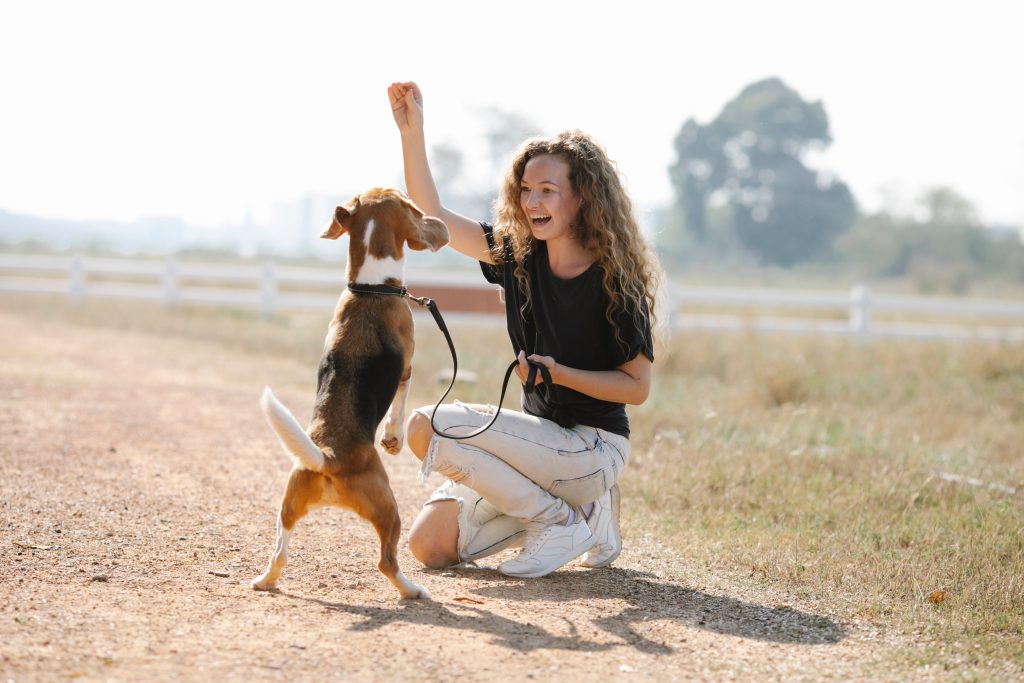In this blog post, we will delve into the fundamental principles and benefits of positive reinforcement training. We will explore the science behind this humane training method, understanding how it influences a dog’s behavior and fosters a strong bond between you and your furry friend. Together, we will uncover the potential of positive reinforcement training to shape your dog’s actions, encourage good manners, and cultivate a harmonious household.

The Science of Positive Reinforcement
The science behind positive reinforcement training for dogs is rooted in the principles of behavioral psychology and learning theory. Understanding these concepts can shed light on why positive reinforcement is an effective and humane approach to training dogs.
- Operant Conditioning: Positive reinforcement training is based on the principles of operant conditioning, a form of learning in which behavior is influenced by its consequences. According to this theory, behaviors that are followed by a positive outcome or reward are more likely to be repeated in the future. In contrast, behaviors that lead to negative consequences or lack of reward are less likely to be repeated.
- Rewards and Reinforcement: Positive reinforcement involves providing a reward or desired consequence immediately after a dog displays a desired behavior. Rewards can include treats, praise, petting, playtime, or any other positive stimulus that motivates the dog. By associating the behavior with a pleasurable outcome, the dog learns that repeating the behavior leads to positive experiences.
- Motivation and Engagement: Positive reinforcement training focuses on understanding and catering to a dog’s individual motivations. It recognizes that different dogs may be motivated by various rewards, such as food, toys, or social interaction. By identifying and utilizing the right rewards, trainers can engage the dog’s interest, making the training process enjoyable and encouraging active participation.
- Timing and Consistency: Timing is crucial in positive reinforcement training. The reward must be delivered immediately after the desired behavior to establish a clear association between the action and the consequence. Consistency in rewarding the desired behavior further reinforces the dog’s understanding of what is expected, helping to shape and solidify the behavior over time.
- Positive Emotional Association: Positive reinforcement training fosters a positive emotional association with the training process. Since rewards are used to reinforce good behavior, dogs come to associate training sessions with enjoyable experiences. This positive emotional state promotes a willing and enthusiastic attitude toward learning, enhancing the dog’s engagement and responsiveness.
- Relationship Building: Positive reinforcement training strengthens the bond between the dog and the trainer or owner. By focusing on rewards and encouragement rather than punishment or force, it creates a relationship based on trust, respect, and cooperation. Dogs trained using positive reinforcement are more likely to see their owners as a source of guidance and support, fostering a stronger connection.
The science behind positive reinforcement training supports its effectiveness in shaping desired behaviors, improving obedience, and promoting a harmonious relationship between dogs and their owners. By understanding the principles of operant conditioning and utilizing positive rewards, trainers can create a positive learning environment that motivates dogs to learn and thrive.
Positive Reinforcement Techniques
Positive reinforcement training methods emphasize rewarding desired behaviors to encourage their repetition, while minimizing the use of punishment or aversive techniques. Here are some key aspects and techniques commonly used in positive reinforcement training for dogs:
- Marker Training: Marker training is a technique that involves using a distinct sound or word (such as a clicker or verbal cue) to mark the precise moment when the dog exhibits the desired behavior. This marker acts as a bridge between the behavior and the reward, helping the dog understand which action led to the positive outcome.
- Rewards and Treats: Treats are a commonly used reward in positive reinforcement training. Small, soft, and highly enticing treats are often preferred as they can be delivered quickly and consumed easily. However, rewards can also include praise, petting, playtime, access to toys, or any other positive stimulus that motivates the dog.
- Shaping: Shaping is a technique that involves breaking down complex behaviors into smaller, more manageable steps. The trainer reinforces and rewards each successive approximation of the desired behavior, gradually shaping the dog’s behavior towards the final goal. This method allows the dog to understand and succeed in small increments, building confidence and motivation.
- Capturing: Capturing involves rewarding a dog for naturally exhibiting a desired behavior. When the dog performs the behavior spontaneously, the trainer promptly marks and rewards it. This technique is particularly useful for shaping behaviors that occur naturally, such as sitting, lying down, or offering a paw.
- Luring: Luring involves using a reward (usually a treat) to guide the dog into the desired position or behavior. The treat acts as a lure to entice the dog to follow it with their nose, body, or paws. Once the dog is in the desired position, the behavior is marked and rewarded. Over time, the lure is gradually phased out, and the dog responds to verbal cues or hand signals alone.
- Clicker Training: Clicker training is a form of positive reinforcement training that uses a handheld device called a clicker. The clicker makes a distinctive sound, signaling to the dog that they have performed the correct behavior and will receive a reward. Clicker training allows for precise timing and clear communication, making it an effective method for teaching new behaviors and shaping existing ones.
- Consistency and Timing: Consistency and timely reinforcement are crucial in positive reinforcement training. The reward must be given immediately after the desired behavior to establish a clear association. Consistency in rewarding the behavior helps the dog understand what is expected of them and reinforces the desired response.
Remember that positive reinforcement training focuses on encouraging desired behaviors rather than punishing unwanted ones. Redirecting the dog’s attention, ignoring undesired behaviors, and rewarding alternative behaviors can help address and modify unwanted actions effectively.

In conclusion, positive reinforcement training stands as a powerful and effective approach to shaping your dog’s behavior and nurturing a strong bond based on trust and respect. By focusing on rewarding desired behaviors rather than resorting to punishment, positive reinforcement training methods have gained popularity for their humane and science-backed approach.
Read more blog posts on our website here.



